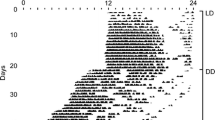Summary
The arousal caused by the 3 h presentation of female socio-sexual cues to male hamsters given an 8 h advance of the light-dark cycle caused an acceleration in the rate of re-entrainment to this new light-dark cycle. This accelerating effect was seen most clearly in animals allowed to run in their wheels in response to a nearby female hamster in estrous condition. However, wheel-running was not a necessary condition for enhancement. In one experiment, males with their wheels prevented from rotating also showed an accelerated rate of re-entrainment; in another experiment, the effect was almost significant (P=0.058). Mating itself seemed to counteract this accelerating effect. Males aroused by nearby but inaccessible estrous females re-entrained quicker than males allowed to mate with an estrous female. Lastly, male hamsters placed in a novel wheel but not allowed to run showed a variable rate of re-entrainment to an 8 h light-dark cycle advance; individuals judged to be sleeping during most of the 3 h in the novel wheel took longer to re-entrain than those judged to be awake during most of the 3 h. These results suggest that there is a general arousal mechanism through which non-specific, non-photic events can enhance the phase advancing actions of a lightentrainable clock.
Similar content being viewed by others
References
Aschoff J, von Goetz C (1988) Masking of circadian activity rhythms in male golden hamsters by the presence of females. Behav Ecol Sociobiol 22:409–412
Boulos Z, Terman M (1980) Food availability and daily biological rhythms. Neurosci Biobeh Rev 4:119–131
Bunnell BN, Boland BD, Dewsbury DA (1977) Copulatory behavior of golden hamsters (Mesocricetus auratus). Behav 61:180–205
Daan S, Pittendrigh CS (1976) A functional analysis of circadian pacemakers in nocturnal rodents. III. Heavy water and constant light: homeostasis or frequency? J Comp Physiol 106:253–266
Davis FC, Stice S, Menaker M (1987) Activity and reproductive state in the hamster: independent control by social stimuli and a circadian pacemaker. Physiol Behav 40:583–590
Ellis GB, McKlveen RE, Turek FW (1982) Dark pulses affect the circadian rhythm of activity in hamsters kept in constant light. Am J Physiol 242:R44-R50
Gwinner E (1966) Periodicity of a circadian rhythm in birds by species-specific song cycles (Aves, Fringillidae: Carduelis spinus, Serinus serinus). Experientia 22:765–766
Honrado GI (1987) The effects of sociosexual cues on the lightentrained and free-running circadian activity rhythms of male golden hamsters, Mesocricetus auratus. M. Sc. Thesis, Department of Zoology, University of Toronto
Huck UW, Lisk RD, Thierjung C (1986) Stimulus requirements for pregnancy initiation in the golden hamster (Mesocricetus auratus) change with time of mating during the receptive period. J Reprod Fert 776:449–458
Lees JG, Hallonquist JD, Mrosovsky N (1983) Differential effects of dark pulses on the two components of split circadian activity rhythms in golden hamsters. J Comp Physiol 153:123–132
Lindberg RG, Hayden P (1974) Thermoperiodic entrainment of arousal from torpor in the little pocket mouse, Perognathus longimembris. Chronobiologia 1:356–361
Lohmann M, Enright JT (1967) The influence of mechanical noise on the activity rhythms of finches. Comp Biochem Physiol 22:289–296
Marimuthu G, Rajan S, Chandrashekaran MK (1981) Social entrainment of the circadian rhythm in the flight activity of the microchiropteran bat Hipposideros speoris. Behav Ecol Sociobiol 8:147–150
Menaker M, Eskin A (1966) Entrainment of circadian rhythms by sound in Passer domesticus. Science 154:1579–1581
Mrosovsky N (1988) Phase response curves for social entrainment. J Comp Physiol A 162:35–46
Mrosovsky N (in press) Non-photic enhancement of adjustment to new light-dark cycles: masking interpretation discounted. J Biol Rhythms
Mrosovsky N, Salmon P (1987) A behavioural method for accelerating re-entrainment of rhythms to new light-dark cycles. Nature 330:372–373
Reebs SG (1989) Acoustical entrainment of circadian activity rhythms in house sparrows: constant light is not necessary. Ethology 80:172–181
Reebs SG, Mrosovsky N (1989) Effects of induced wheel running on the circadian activity rhythms of syrian hamsters: entrainment and phase response curve. J Biol Rhythms 4:39–48
Regal PJ, Connolly MS (1980) Social influences on biological rhythms. Behav 72:171–199
Steel E (1979) Short-term, postcopulatory changes in receptive and proceptive behavior in the female syrian hamster (Mesocricetus auratus). Horm Behav 12:280–292
Stephan FK (1984) Phase shifts of circadian rhythms in activity entrained to food access. Physiol Behav 32:663–671
Tokura H, Aschoff J (1983) Effects of temperature on the circadian rhythms of pig-tailed macacques, Macaca nemestrina. Am J Physiol 245:R800-R804
Turek FW, Losee-Olson S (1986) A benzodiazepine used in the treatment of insomnia phase-shifts the mammalian circadian clock. Nature 321:167–168
Van Reeth O, Turek FW (1987) Adaptation of circadian rhythmicity to shift in light-dark cycle accelerated by a benzodiazepine. Am J Physiol 253:R204-R207
Yamada N, Shimoda K, Ohi K, Takahashi S, Takahashi K (1988) Free-access to a running wheel shortens the period of free-running rhythm in blinded rats. Physiol Behav 42:87–91
Author information
Authors and Affiliations
Rights and permissions
About this article
Cite this article
Honrado, G.I., Mrosovsky, N. Arousal by sexual stimuli accelerates the re-entrainment of hamsters to phase advanced light-dark cycles. Behav Ecol Sociobiol 25, 57–63 (1989). https://doi.org/10.1007/BF00299711
Received:
Accepted:
Issue Date:
DOI: https://doi.org/10.1007/BF00299711




